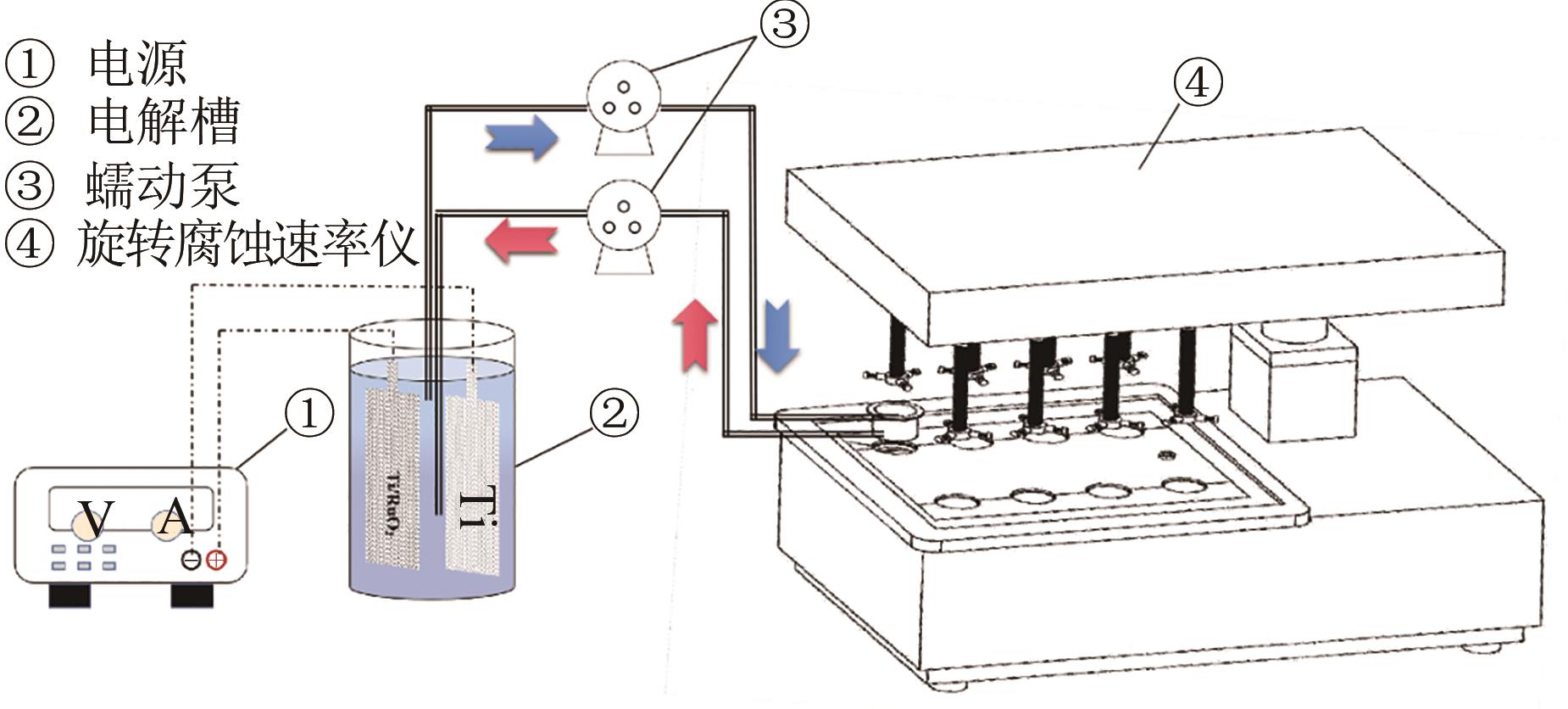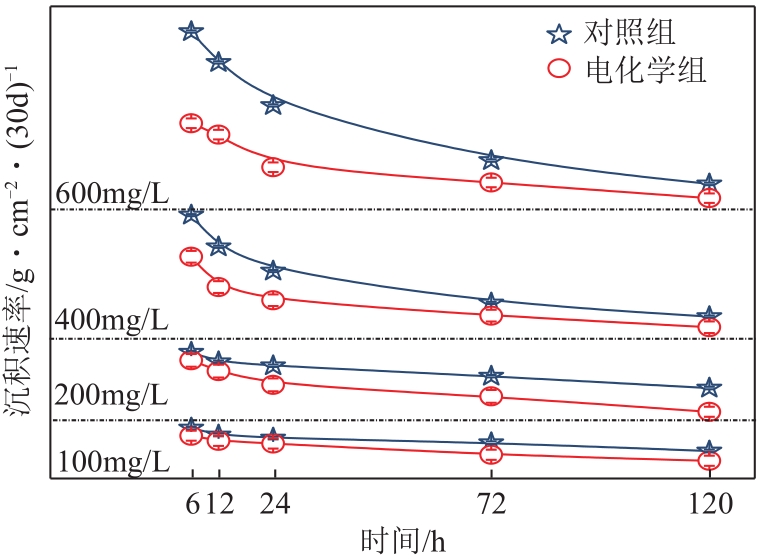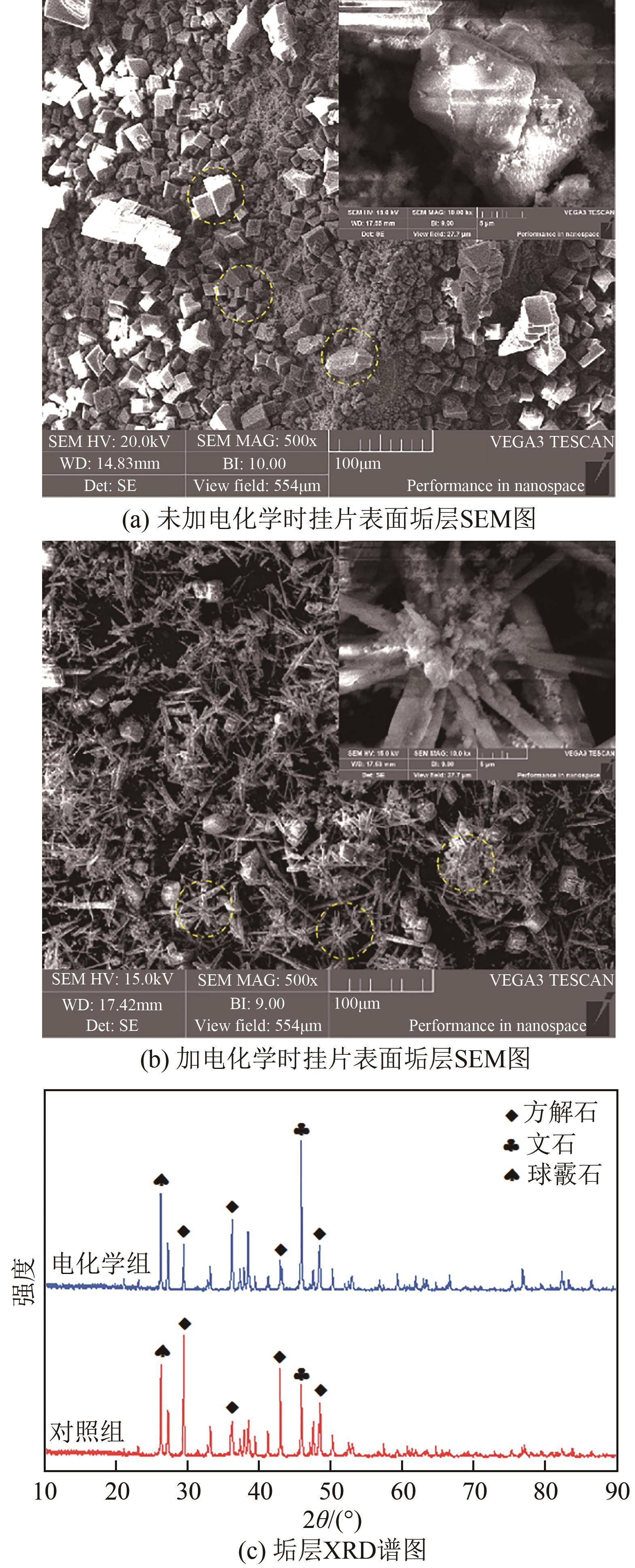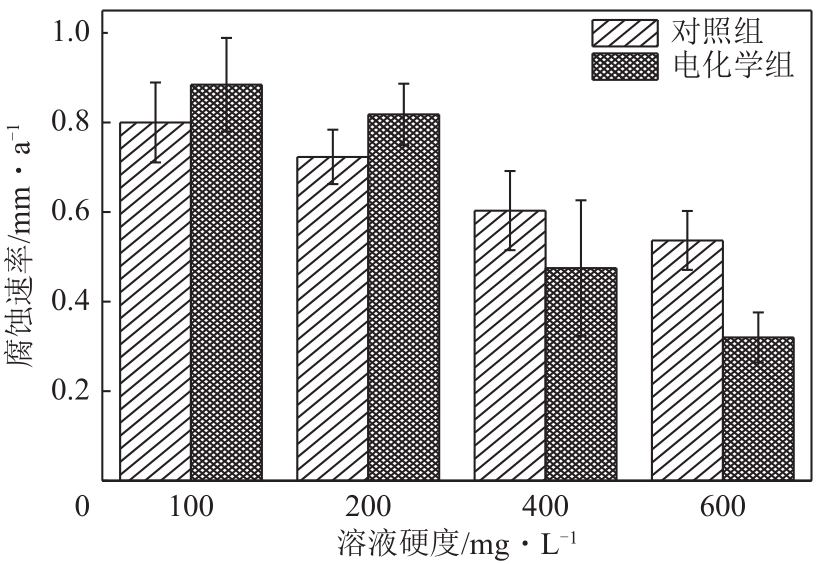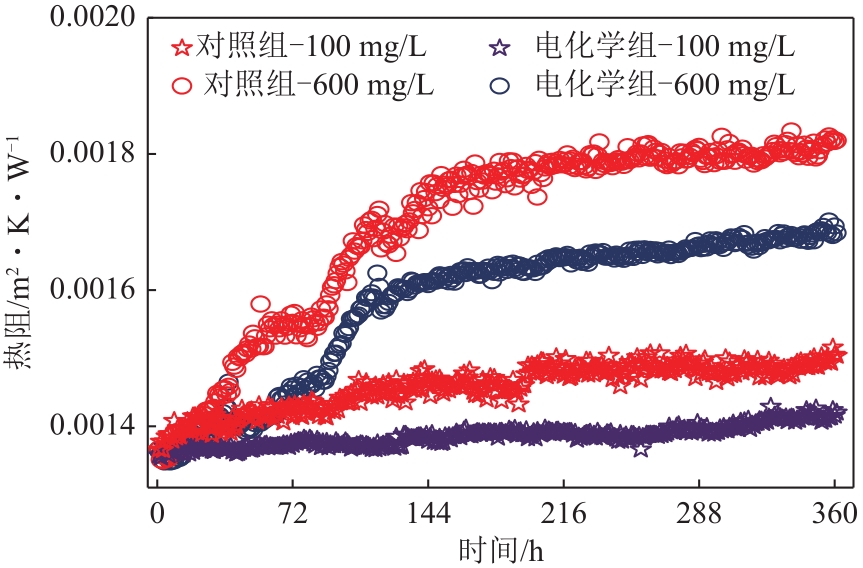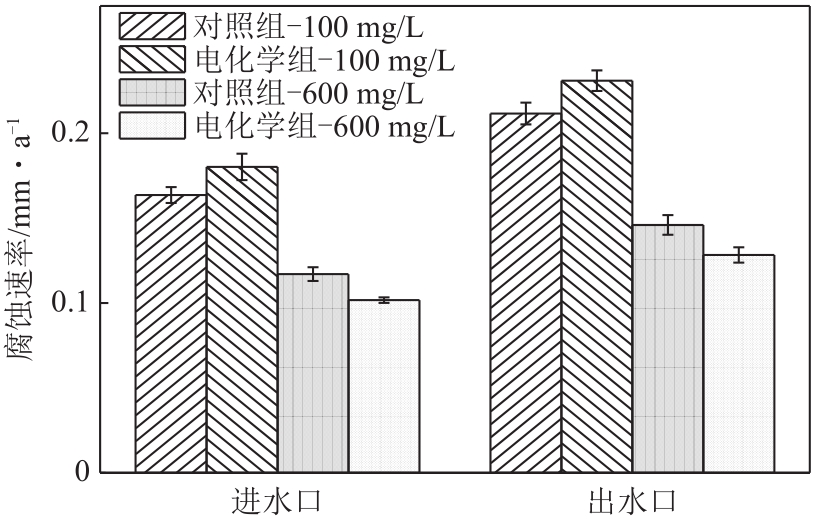Chemical Industry and Engineering Progress ›› 2023, Vol. 42 ›› Issue (4): 2142-2150.DOI: 10.16085/j.issn.1000-6613.2022-1141
• Resources and environmental engineering • Previous Articles Next Articles
Electrochemical effects on fouling and corrosion of carbon steel in circulating cooling water systems
LU Sijia1( ), LI Xiaoliang1,2(
), LI Xiaoliang1,2( ), ZHAO Huiyan2, TIAN Zhijuan2, ZHENG Xing1(
), ZHAO Huiyan2, TIAN Zhijuan2, ZHENG Xing1( )
)
- 1.State Key Laboratory of Eco-Hydraulic in Northwest Arid Region, Xi’an University of Technology, Xi’an 710048, Shaanxi, China
2.Sinopec Luoyang Company, Luoyang 471012, Henan, China
-
Received:2022-06-17Revised:2022-11-28Online:2023-05-08Published:2023-04-25 -
Contact:LI Xiaoliang, ZHENG Xing
电化学对循环冷却水系统碳钢的结垢与腐蚀影响
路思佳1( ), 李晓良1,2(
), 李晓良1,2( ), 赵会艳2, 田志娟2, 郑兴1(
), 赵会艳2, 田志娟2, 郑兴1( )
)
- 1.西安理工大学西北旱区生态水利国家重点实验室,陕西 西安 710048
2.中国石油化工股份有限公司洛阳分公司,河南 洛阳 471012
-
通讯作者:李晓良,郑兴 -
作者简介:路思佳(1993—),男,博士研究生,研究方向为循环冷却水处理。E-mail:664289632@qq.com。 -
基金资助:国家自然科学基金(52100104)
CLC Number:
Cite this article
LU Sijia, LI Xiaoliang, ZHAO Huiyan, TIAN Zhijuan, ZHENG Xing. Electrochemical effects on fouling and corrosion of carbon steel in circulating cooling water systems[J]. Chemical Industry and Engineering Progress, 2023, 42(4): 2142-2150.
路思佳, 李晓良, 赵会艳, 田志娟, 郑兴. 电化学对循环冷却水系统碳钢的结垢与腐蚀影响[J]. 化工进展, 2023, 42(4): 2142-2150.
share this article
Add to citation manager EndNote|Ris|BibTeX
URL: https://hgjz.cip.com.cn/EN/10.16085/j.issn.1000-6613.2022-1141
| 1 | 徐志明, 张一龙, 王景涛, 等. 两种阴离子对析晶污垢沉积的影响[J]. 化工学报, 2015, 66(6): 2268-2273. |
| XU Zhiming, ZHANG Yilong, WANG Jingtao, et al. Effect of two kinds of anions on crystallization fouling deposition[J]. CIESC Journal, 2015, 66(6): 2268-2273. | |
| 2 | ZHU Haifeng, et al. Effect of electrochemical pretreatment on the control of scaling and fouling caused by circulating cooling water on heat exchanger and side-stream reverse osmosis membrane[J]. Journal of Water Process Engineering, 2021, 43: 102261. |
| 3 | 彭力, 许萍, 张雅君, 等. 工业循环冷却水系统中运行条件对污垢的影响[J]. 水处理技术, 2016, 42(4): 46-50. |
| PENG Li, XU Ping, ZHANG Yajun, et al. Effects of running conditions on fouling in industrial circulating cooling water system[J]. Technology of Water Treatment, 2016, 42(4): 46-50. | |
| 4 | HU Jiayuan, CAO Shunan, XIE Jianli. EIS study on the corrosion behavior of rusted carbon steel in 3% NaCl solution[J]. Anti-Corrosion Methods and Materials, 2013, 60(2): 100-105. |
| 5 | 时利香, 王信粉, 李薇, 等. 循环冷却水系统新型缓蚀剂应用进展[J]. 应用化工, 2019, 48(10): 2427-2430. |
| SHI Lixiang, WANG Xinfen, LI Wei, et al. Progress in application of new corrosion inhibitors for circulating cooling water systems[J]. Applied Chemical Industry, 2019, 48(10): 2427-2430. | |
| 6 | 吕胜杰, 程学群, 段振国, 等. 循环水中氯离子含量对碳钢腐蚀行为影响规律的研究[J]. 石油炼制与化工, 2011, 42(3): 84-87. |
| Shengjie LYU, CHENG Xuequn, DUAN Zhenguo, et al. Effect of chloride ion content in circulating water on the corrosion behavior of carbon steel[J]. Petroleum Processing and Petrochemicals, 2011, 42(3): 84-87. | |
| 7 | WANG Yetao, CHEN Hualin, ZHANG Zhijian, et al. Synthesis and characterization of PBTCA-modified hyperbranched polyether corrosion and scale inhibitors[J]. Journal of Applied Polymer Science, 2019, 136(38): 48041. |
| 8 | LI Shunling, QU Qing, LI Lei, et al. Bacillus cereus s-EPS as a dual bio-functional corrosion and scale inhibitor in artificial seawater[J]. Water Research, 2019, 166: 115094. |
| 9 | LI Heng. Control of mineral scale deposition in cooling systems using secondary-treated municipal wastewater[J]. Water Research, 2011, 45(2): 748-760. |
| 10 | 钱凯凯, 胡将军. 电解参数对循环冷却水处理及倒极除垢效果的影响[J]. 工业水处理, 2020, 40(1): 83-86. |
| QIAN Kaikai, HU Jiangjun. Influence of electrolysis parameters on the treatment of circulating cooling water and the descaling effect of reversing electrodes[J]. Industrial Water Treatment, 2020, 40(1): 83-86. | |
| 11 | ZHI Suli. Hardness removal by a novel electrochemical method[J]. Desalination, 2016, 381: 8-14. |
| 12 | HASSON David. Calcium carbonate hardness removal by a novel electrochemical seeds system[J]. Desalination, 2010, 263(1/2/3): 285-289. |
| 13 | JIN Huachang, et al. Polarity reversal electrochemical process for water softening[J]. Separation and Purification Technology, 2019, 210: 943-949. |
| 14 | LI Xianhui. Intermediate concentrate demineralization techniques for enhanced brackish water reverse osmosis water recovery—A review[J]. Desalination, 2019, 466: 24-35. |
| 15 | LIU Bo, GUO Wanqian, REN Nanqi. Decontamination of wastewaters containing synthetic organic dyes by electrochemical methods: A review[J]. Advanced Materials Research, 2013, 788: 405-408. |
| 16 | 路思佳, 郑兴, 李晓良. 化学还原氧化石墨烯修饰PbO2电极及催化降解酸性红G[J]. 中国环境科学, 2021, 41(8): 3635-3641. |
| LU Sijia, ZHENG Xing, LI Xiaoliang. Chemically reduced graphene oxide modified PbO2 electrodes and the degradation of acidic red G[J]. China Environmental Science, 2021, 41(8): 3635-3641. | |
| 17 | YU Yang, JIN Huachang, MENG Pengjun, et al. Electrochemical water softening using air-scoured washing for scale detachment[J]. Separation and Purification Technology, 2018, 191: 216-224. |
| 18 | 徐浩, 郭艺菲, 郭思远, 等. 循环冷却水系统使用电化学除垢设备的选择方法[C]//中国环境科学学会2019年科学技术年会论文集, 西安, 2019. |
| Xu Hao, Guo Yifei, Guo Siyuan, et al. Selection of electrochemical scale removal equipment for circulating cooling water system[C]//2019 Annual Conference of Science and Technology of Chinese Society for Environmental Sciences, Xi'an, 2019. | |
| 19 | 徐浩, 延卫. 阴极电流密度对电化学除垢技术生成水垢的影响[J]. 西安交通大学学报, 2013, 47(7): 47-51. |
| XU Hao, YAN Wei. Effect of cathode current density on scale generated by electrochemical scale removal technique[J]. Journal of Xi'an Jiaotong University, 2013, 47(7): 47-51. | |
| 20 | XU Hao, XU Zhicheng, GUO Yifei, Y et al. Research and application progress of electrochemical water quality stabilization technology for recirculating cooling water in China: A short review[J]. Journal of Water Process Engineering, 2020, 37: 101433. |
| 21 | 徐浩, 延卫, 汤成莉. 水垢的电化学去除工艺与机理研究[J]. 西安交通大学学报, 2009, 43(5): 104-108. |
| XU Hao, YAN Wei, TANG Chengli. Technology and mechanism of water scale removal by electrochemical method[J]. Journal of Xi'an Jiaotong University, 2009, 43(5): 104-108. | |
| 22 | 徐浩, 袁孟孟, 罗清林, 等. 电化学水垢去除技术中试实验研究[J]. 工业水处理, 2019, 39(7): 37-41. |
| XU Hao, YUAN Mengmeng, LUO Qinglin, et al. Experimental study on pilot test of electrochemical scale removal technology[J]. Industrial Water Treatment, 2019, 39(7): 37-41. | |
| 23 | 李森, 王海峰. 电化学法处理冷却循环水技术的应用[J]. 化工进展, 2013, 32(10): 2514-2517. |
| LI Sen, WANG Haifeng. Application of electrochemical technology in the treatment of circulating cooling water[J]. Chemical Industry and Engineering Progress, 2013, 32(10): 2514-2517. | |
| 24 | ZHANG Chunhui. Investigation on an electrochemical pilot equipment for water softening with an automatic descaling system: Parameter optimization and energy consumption analysis[J]. Journal of Cleaner Production, 2020, 276: 123178. |
| 25 | CLAUWAERT Peter. Electrochemical tap water softening: A zero chemical input approach[J]. Water Research, 2020, 169: 115263. |
| 26 | 段慧萍. 电化学新工艺在循环水处理装置中的应用[J]. 煤化工, 2018, 46(3): 30-33. |
| DUAN Huiping. Application of new electrochemical process in circulating water treatment unit[J]. Coal Chemical Industry, 2018, 46(3): 30-33. | |
| 27 | 王仕文, 贺胜如, 张连波, 等. 循环水电化学处理技术在大榭石化的工业化应用[J]. 工业水处理, 2018, 38(6): 96-99. |
| WANG Shiwen, HE Shengru, ZHANG Lianbo, et al. Industrial application of electrochemical treatment technology to the circulating water system in Daxie Petrochemical Co., Ltd.[J]. Industrial Water Treatment, 2018, 38(6): 96-99. | |
| 28 | 刘上月, 磨冠龙. 浅谈电化学设备在钢铁企业循环冷却水处理中的运用[J]. 科学技术创新, 2021(18): 185-186. |
| LIU Shangyue, MO Guanlong. Talking about the application of electrochemical equipment in the treatment of circulating cooling water in iron and steel enterprises[J]. Scientific and Technological Innovation, 2021(18): 185-186. | |
| 29 | 胡艳华, 郦和生. Ca2+浓度和碱度对循环水结垢和腐蚀的影响[J]. 石化技术, 2012, 19(2): 9-11. |
| HU Yanhua, LI Hesheng. The scaling and corrosion in circulated water influenced from alkalinity and concentration of Ca2+ [J]. Petrochemical Industry Technology, 2012, 19(2): 9-11. | |
| 30 | ZHANG Chunli, HE Yi, XU Zhonghao, et al. Fabrication of Fe3O4 @SiO2 nanocomposites to enhance anticorrosion performance of epoxy coatings[J]. Polymers for Advanced Technologies, 2016, 27(6): 740-747. |
| 31 | 刘卫国, 刘建东, 赵陈龙. 水的磁处理防腐蚀机理研究[J]. 腐蚀与防护, 2006, 27(4): 196-198. |
| LIU Weiguo, LIU Jiandong, ZHAO Chenlong. Corrosion-prevention mechanism in magnetic treatment of water[J]. Corrosion & Protection, 2006, 27(4): 196-198. | |
| 32 | 欧阳志, 弓志定, 高晶, 等. 无磷配方在煤化工循环冷却水系统中的应用研究[J]. 工业水处理, 2019, 39(12): 110-112. |
| OUYANG Zhi, GONG Zhiding, GAO Jing, et al. Application of non-phosphorus formula in coal chemical circulating cooling water system[J]. Industrial Water Treatment, 2019, 39(12): 110-112. | |
| 33 | 曹生现, 赵振超, 李思博, 等. 循环冷却水处理在线监控评价设备的开发[J]. 化工学报, 2015, 66(7): 2649-2655. |
| CAO Shengxian, ZHAO Zhenchao, LI Sibo, et al. Development of online monitoring and evaluation device for treatment of circulating cooling water[J]. CIESC Journal, 2015, 66(7): 2649-2655. |
| [1] | ZHAO Wei, ZHAO Deyin, LI Shihan, LIU Hongda, SUN Jin, GUO Yanqiu. Synthesis and application of triazine drag reducing agent for nature gas pipeline [J]. Chemical Industry and Engineering Progress, 2023, 42(S1): 391-399. |
| [2] | LEI Wei, JIANG Weijia, WANG Yugao, HE Minghao, SHEN Jun. Synthesis of N,S co-doped coal-based carbon quantum dots by electrochemical oxidation and its application in Fe3+ detection [J]. Chemical Industry and Engineering Progress, 2023, 42(9): 4799-4807. |
| [3] | SONG Weitao, SONG Huiping, FAN Zhenlian, FAN Biao, XUE Fangbin. Research progress of fly ash in anti-corrosion coatings [J]. Chemical Industry and Engineering Progress, 2023, 42(9): 4894-4904. |
| [4] | WANG Shuaiqing, YANG Siwen, LI Na, SUN Zhanying, AN Haoran. Research progress on element doped biomass carbon materials for electrochemical energy storage [J]. Chemical Industry and Engineering Progress, 2023, 42(8): 4296-4306. |
| [5] | WANG Xin, WANG Bingbing, YANG Wei, XU Zhiming. Anti-scale and anti-corrosion properties of PDA/PTFE superhydrophobic coating on metal surface [J]. Chemical Industry and Engineering Progress, 2023, 42(8): 4315-4321. |
| [6] | LIU Zhanjian, FU Yuxin, REN Lina, ZHANG Xiguang, YUAN Zhongtao, YANG Nan, WANG Huaiyuan. New research progress of superhydrophobic coatings in the field of anti-corrosion and anti-scaling [J]. Chemical Industry and Engineering Progress, 2023, 42(6): 2999-3011. |
| [7] | LI Ruidong, HUANG Hui, TONG Guohu, WANG Yueshe. Hygroscopic properties and corrosion behavior of ammonium salt in a crude oil distillation column [J]. Chemical Industry and Engineering Progress, 2023, 42(6): 2809-2818. |
| [8] | HE Yang, LI Siying, LI Chuanqiang, YUAN Xiaoya, ZHENG Xuxu. Anticorrosion performance of thermal reduction graphene oxide /epoxy resin composite coating [J]. Chemical Industry and Engineering Progress, 2023, 42(4): 1983-1994. |
| [9] | DU Baoning, ZHAO Shan, LIU Xiangqing, ZHANG Yi, XIAO Yaru, ZHANG Shaofei, LI Tiantian, SUN Jinfeng. Preparation and properties of nano porous CuMn-based oxide electrodes [J]. Chemical Industry and Engineering Progress, 2023, 42(3): 1484-1492. |
| [10] | SUN Hui, MENG Xianghai, WEI Jinghai, ZHOU Hongjun, XU Chunming. New scene for ammonia synthesis by green hydrogen [J]. Chemical Industry and Engineering Progress, 2023, 42(2): 1098-1102. |
| [11] | YANG Qingzheng, ZHANG Tailiang, LIU Congsheng, BAI Yi, CHENG Xin, ZHENG Cunchuan. Preparation and inhibition mechanism of gemini imidazoline quaternary ammonium salt inhibitor [J]. Chemical Industry and Engineering Progress, 2023, 42(10): 5436-5444. |
| [12] | MIAO Jiaxu, CHEN Xianjiang, ZHOU Yangyang, YUN Zhiqiang, ZHANG Yuhong, BI Haisheng. Corrosion acoustic emission signal analysis of X90 pipeline steel based on blind deconvolution algorithm [J]. Chemical Industry and Engineering Progress, 2022, 41(S1): 60-71. |
| [13] | LONG Yinying, YANG Jian, GUAN Min, YANG Yiluo, CHENG Zhengbai, CAO Haibing, LIU Hongbin, AN Xingye. Research progress of lignin-based materials in electrode materials for hybrid supercapacitors [J]. Chemical Industry and Engineering Progress, 2022, 41(9): 4855-4865. |
| [14] | LOU Rui, LIU Yu, TIAN Jie, ZHANG Yanan. Preparation of LNP-based hierarchical porous carbon and its electrochemical properties [J]. Chemical Industry and Engineering Progress, 2022, 41(6): 3170-3177. |
| [15] | LI Boshen, WEI Ming, HU Yaoyao, DONG Yuelin, DONG Qunfeng, YANG Lifeng. Preparation and performance of modified h-BN/polyurethane acrylic coatings [J]. Chemical Industry and Engineering Progress, 2022, 41(6): 3194-3202. |
| Viewed | ||||||
|
Full text |
|
|||||
|
Abstract |
|
|||||
